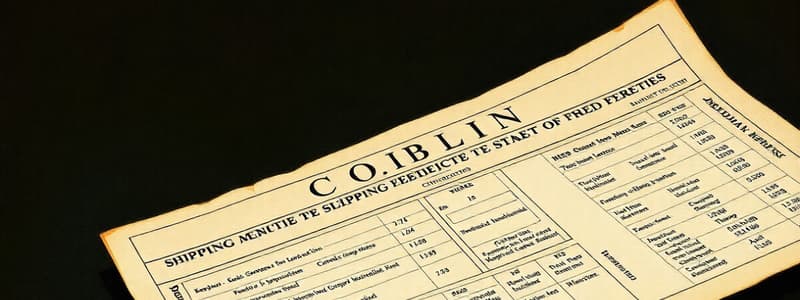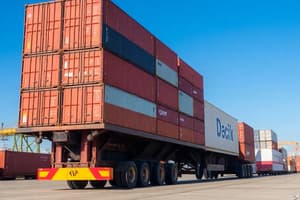Podcast
Questions and Answers
What is the primary function of a Bill of Lading in the shipping process?
What is the primary function of a Bill of Lading in the shipping process?
- To calculate the landed cost of goods
- To indicate the expected delivery date of the goods
- To provide a legal receipt of payment and detail shipment information (correct)
- To facilitate the return of damaged goods
How does the DDP Incoterm benefit the buyer?
How does the DDP Incoterm benefit the buyer?
- The buyer must arrange for local delivery
- The seller delivers goods alongside the shipping vessel
- The buyer is responsible for all shipping costs
- The seller takes care of duties and tariffs for importation (correct)
Which Incoterm indicates that the seller is responsible only until the goods are on their premises?
Which Incoterm indicates that the seller is responsible only until the goods are on their premises?
- FCA
- DAP
- CIP
- EXW (correct)
What distinguishes DAT from DAP in Incoterms?
What distinguishes DAT from DAP in Incoterms?
What is a significant advantage of cross docking for a business?
What is a significant advantage of cross docking for a business?
Which of the following is NOT a benefit of understanding and using Correct Incoterms?
Which of the following is NOT a benefit of understanding and using Correct Incoterms?
Which Incoterm involves the seller having responsibility for both transportation charges and insurance?
Which Incoterm involves the seller having responsibility for both transportation charges and insurance?
What is the potential drawback of not using a Bill of Lading in shipping?
What is the potential drawback of not using a Bill of Lading in shipping?
Which statement accurately describes the FIFO method in supply chain management?
Which statement accurately describes the FIFO method in supply chain management?
What is included in the landed cost of an item in supply chain management?
What is included in the landed cost of an item in supply chain management?
In the context of back ordering, which scenario would likely necessitate this practice?
In the context of back ordering, which scenario would likely necessitate this practice?
What is the primary purpose of a bill of lading in the logistics process?
What is the primary purpose of a bill of lading in the logistics process?
How do Incoterms impact international shipping agreements?
How do Incoterms impact international shipping agreements?
Which of the following characteristics defines the LIFO method in supply chain management?
Which of the following characteristics defines the LIFO method in supply chain management?
What is one potential consequence of adopting a just-in-time manufacturing approach?
What is one potential consequence of adopting a just-in-time manufacturing approach?
Which situation represents an appropriate use of FIFO methodology?
Which situation represents an appropriate use of FIFO methodology?
Flashcards are hidden until you start studying
Study Notes
Shipping Documents: The Bill of Lading
- A Bill of Lading (B/L) is a document outlining the type, quantity, and destination of goods being shipped.
- Required for all land, sea, and air transport.
- Serves as a legal receipt of payment and must be signed by the seller/shipper, carrier, and buyer/receiver upon goods' arrival.
Cross Docking: Streamlining the Supply Chain
- Cross Docking is a method of quickly moving goods from vendors to customers without extended storage.
Incoterms: International Trade Agreements
- Incoterms are internationally recognized rules defining seller and buyer responsibilities during export transactions.
Ex Works (EXW)
- Seller fulfills its obligation when goods are ready for pickup at the seller's premises.
Free Carrier (FCA)
- Seller delivers goods to the carrier or buyer-designated individual at the seller's premises.
Carriage Paid To (CPT)
- Seller delivers goods at an agreed location and pays transport costs to that location.
Carriage and Insurance Paid To (CIP)
- Similar to CPT, the seller pays for insurance to protect the buyer from loss or damage during transit.
- Seller obtains minimum coverage, encouraging buyers to purchase additional protection.
Delivered at Terminal (DAT)
- Seller delivers and unloads goods at a designated terminal (quay, warehouse, shipping yard, etc.).
Delivered at Place (DAP)
- Seller delivers and unloads goods at a named destination for the buyer's disposal.
Delivered Duty Paid (DDP)
- Seller transports goods to a destination, clearing them for import and paying any relevant duties or tariffs.
Free Alongside Ship (FAS)
- Seller places goods alongside the ship at a named port, at the buyer's risk and expense.
Supply Chain Management: A Network of Production and Distribution
- A supply chain is a network between a company and its suppliers to produce and distribute a specific product to the final buyer.
- Involves diverse activities, people, entities, information, and resources.
Key Supply Chain Processes
- Order Generation & Fulfillment: Includes receiving inventory shipments, storage, processing, shipping, and return management.
- Inventory Management: Aims to optimize inventory levels to meet demand while minimizing costs.
- Production: Transformation of raw materials into finished products.
- Distribution: Movement of goods from production sites to customers.
Just-In-Time (JIT) Manufacturing
- Also known as the Toyota Production System (TPS).
- Aims to maximize efficiency and minimize waste by receiving materials only when needed.
- Requires accurate demand forecasting and efficient production processes.
Inventory Management Methods: FIFO & LIFO
- FIFO (First In, First Out): Oldest inventory items are sold first.
- LIFO (Last In, First Out): Newest inventory items are sold first.
Landed Cost: Comprehensive Product Cost
- Includes the purchase price, shipping, custom duties, taxes, and other buyer-incurred charges.
Back Ordering
- Placing orders for products temporarily out of stock and already ordered by customers.
- Usually employed during periods of high demand or when products experience a sudden surge in demand.
Studying That Suits You
Use AI to generate personalized quizzes and flashcards to suit your learning preferences.




